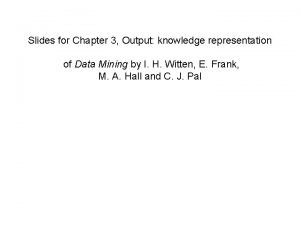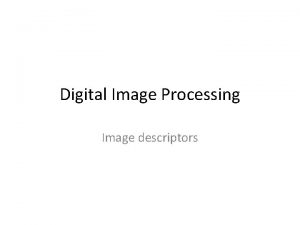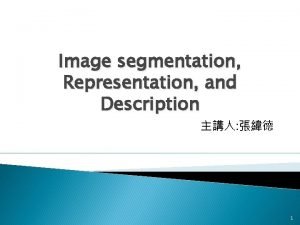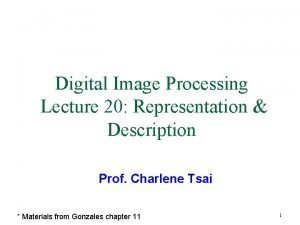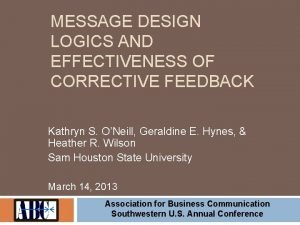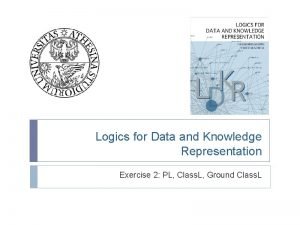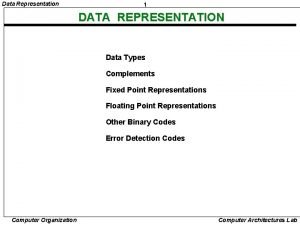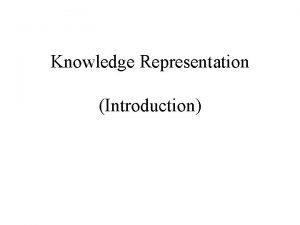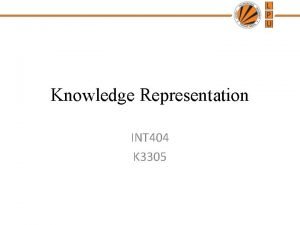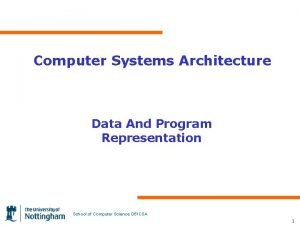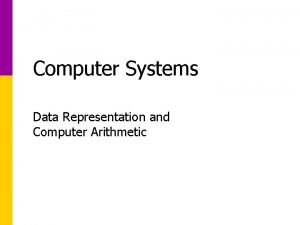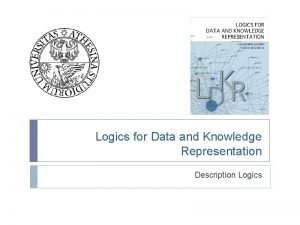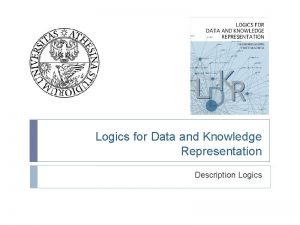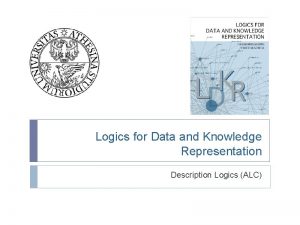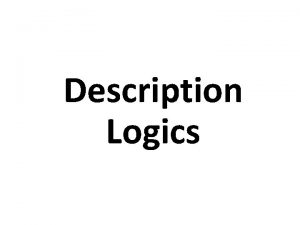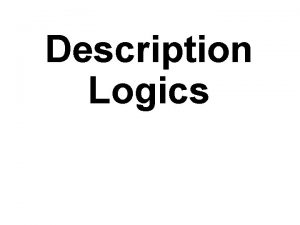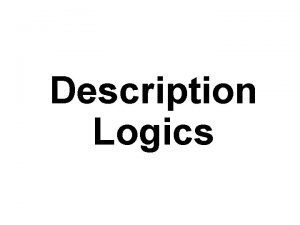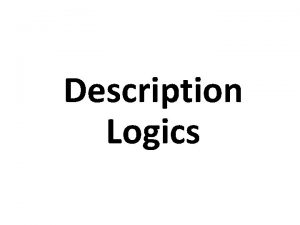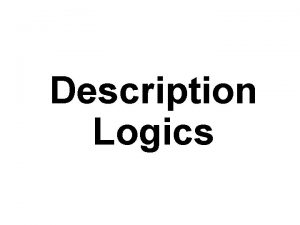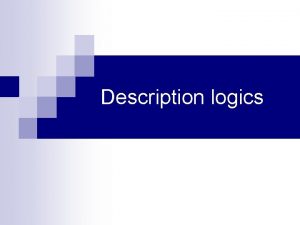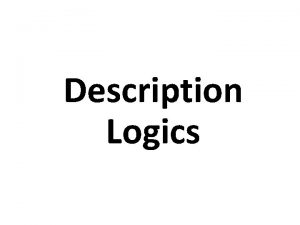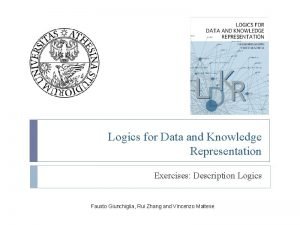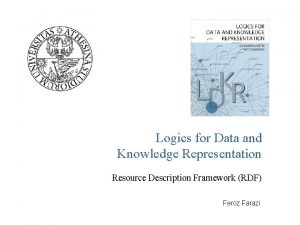Logics for Data and Knowledge Representation Description Logics

















- Slides: 17

Logics for Data and Knowledge Representation Description Logics as query language

Outline From Databases to DL q From ER diagrams to DL q Answering Queries in DL via instance checking q Answering Queries in DL via instance retrieval: tableaux q Answering Queries in DL via graphical representation q 2

Limitations of databases w. r. t. DL Employee Name Role Nationality Supervises Fausto Professor Italian Rui Student Chinese Bisu Student Indian - q No negation q No disjunction q Ambiguous support for incomplete information (null values) q The database represents a single model. q Hence, inference is just model checking. 3

Defining a TBox and ABox for a database Employee Name Role Nationality Supervises Fausto Professor Italian Rui Student Chinese Bisu Student Indian - Individual Class Attribute Relation TBox = {Professor ⊑ Employee, Student ⊑ Employee} ABox = {Professor(Fausto), Student(Rui), Student(Bisu), Nationality(Fausto, Italian), Nationality (Rui, Chinese), Nationality (Bisu, Indian), Supervises(Fausto, Rui), Supervises(Rui, Bisu)} 4

Defining DL theories for ER diagrams q An ER conceptual schema can be expressed as a DL theory q The models of the DL theory correspond to the legal database states of the ER schema. q Reasoning services, such as satisfiability of a schema or of a logical implication, can be performed by the corresponding DL theory. q A DL theory allows for a greater expressivity than the original ER schema, in terms of full disjunction and negation and entity definitions by means of both necessary and sufficient conditions. 5

Define a DL theory for the ER diagram TBox = { Person ⊑ Manager ⊔ Employee, Manager ⊑ Person ⊓ Employee, Employee ⊑ Person ⊓ ∃income-1. Dollar-quantity ⊓ ∃location-1. City Dollar-quantity ⊑ Quantity City ⊑ ∃is-part-1. Region } 6

DL as query language TBox = {} ABox = {Child(John, Mary), Female(Mary)} NL Query: Who are the individuals having only female children? DL Query: T, A ⊨ ∀Child. Female Answer: {John} We can think to a database as a DL theory with one model q ABox services are generally applied to resolve a query q Complexity may go up to CO-NP complete q 7

How to use ABox Reasoning Services ABox Service Description Query Instance retrieval Given a concept C, retrieve all the instances a which satisfy C w. r. t. the ABox A. A⊨C Instance checking Check whether an assertion C(a) is entailed by the ABox, i. e. check whether a belongs to C. A ⊨ C(a) A ⊨ R(a, b) NOTE: this means that before answering we need to expand the ABox (w. r. t. the TBox) and reason on the identified model 8

RECALL: Reasoning via expansion of the ABox q Reasoning services over an ABox w. r. t. an acyclic TBox can be reduced to checking an expanded ABox. q We define the expansion of an ABox A with respect to T as the ABox A’ that is obtained from A by replacing each concept assertion C(a) with the assertion C’(a), with C’ the expansion of C with respect to T. q A is consistent with respect to T iff its expansion A’ is consistent q A is consistent iff A is satisfiable, i. e. non contradictory. 9

Answering Queries via instance checking (I) TBox = {Horse ⊑ Animal, Mule ⊑ Animal} ABox = {Horse(Furia), Parent(Speedy, Furia)} NL Query: Is Furia an animal? DL Query: T, A ⊨ Animal(Furia) YES, in fact the ABox can be expanded as follows: ABox = {Horse(Furia), Animal(Furia), Parent(Speedy, Furia)} 10

Answering Queries via instance checking (II) TBox = {Horse ⊑ Animal ⊓ Mule, Mule ⊑ Animal} ABox = {Horse(Furia), Parent(Speedy, Furia)} NL Query: Is Furia a mule? DL Query: T, A ⊨ Animal(Furia) NO, in fact the ABox can be expanded as follows: ABox = {Horse(Furia), Animal(Furia), Mule(Furia), Parent(Speedy, Furia)} 11

Answering Queries via instance checking (III) TBox = {Horse ⊑ Animal, Mule ⊑ Animal} ABox = {Horse(Furia), Parent(Speedy, Furia)} NL Query: Is Furia a mule? DL Query: T, A ⊨ Mule(Furia) NO (BY CLOSED WORLD ASSUMPTION), in fact the ABox can be expanded as follows: ABox = {Horse(Furia), Animal(Furia), Parent(Speedy, Furia)} If we drop closed world assumption the answer should be I DO NOT KNOW 12

Answering Queries via instance retrieval: Tableaux (I) TBox = {Horse ⊑ Animal, Mule ⊑ Animal} ABox = {Horse(Speedy), Horse(Furia), Parent(Speedy, Furia)} NL Query: Is there any animal which is not both a horse and a mule, and is parent of a horse? DL Query: T, A ⊨ ∃Parent. Horse ⊓ (Horse ⊓ Mule) i. e. is the formula satifiable? 13

Answering Queries via instance retrieval: Tableaux (I) TBox = {Horse ⊑ Animal, Mule ⊑ Animal} ABox = {Horse(Speedy), Horse(Furia), Parent(Speedy, Furia)} Is ∃Parent. Horse ⊓ (Horse ⊓ Mule) satifiable? ⊓-rule A’ = { ∃Parent. Horse(x), (Horse ⊓ Mule)(x)} ∃-rule A’ = {Horse(Furia), Parent(Speedy, Furia), ( Horse ⊔ Mule)(x)} ⊔-rule A’ = {Horse(Furia), Parent(Speedy, Furia), Horse(Speedy)} inconsistent or A’ = {Horse(Furia), Parent(Speedy, Furia), Mule(Speedy)} consistent 14

Answering Queries via graph reasoning NL Query: Does John have a female friend loving a not female? DL Query: ⊨ ∃FRIEND. (Female ⊓ (∃LOVES. Female))(john) 15

Answering Queries via graph reasoning NL Query: Does John have a female friend loving a male? DL Query: 1 ⊨ ∃FRIEND. (Female ⊓ (∃LOVES. Male))(john) 16

Provide the answer for the queries ⊨ ENROLLED(Mary, cs 221) ⊨ Grad(peter) ⊨ Grad(Susan) ⊨ ∃ ENROLLED. Grad (ee 282) ⊨ ∀ TEACHES. Intermediate. Course(bob) 17 ⊨ Grad ⊓ ∃ TEACHES. ⊤ ⊨ Student ⊓ ∀ ENROLLED. ⊤
 Knowledge representation in data mining
Knowledge representation in data mining Representation and description in digital image processing
Representation and description in digital image processing Topological descriptors in image processing
Topological descriptors in image processing Representation and description
Representation and description For a chain code 10103322
For a chain code 10103322 Image representation and description
Image representation and description Message design logics
Message design logics Kr logics
Kr logics Message design logics
Message design logics Sage crm saleslogix
Sage crm saleslogix Q logics
Q logics Sage crm saleslogix
Sage crm saleslogix Data representation in computer organization
Data representation in computer organization Script in knowledge representation
Script in knowledge representation Mapping between facts and representation
Mapping between facts and representation Knowledge creation and knowledge architecture
Knowledge creation and knowledge architecture Data and program representation
Data and program representation Data representation and computer arithmetic
Data representation and computer arithmetic
